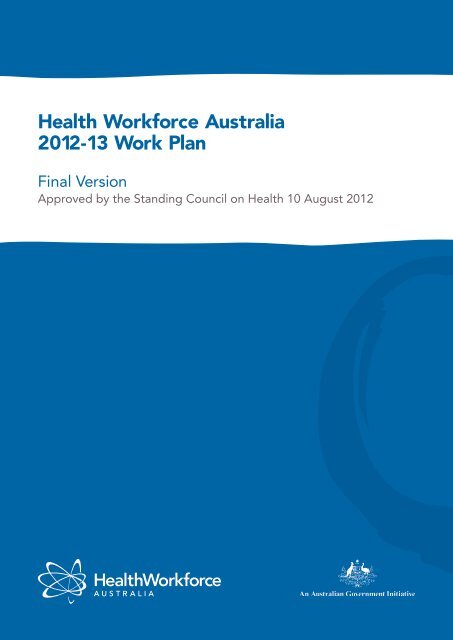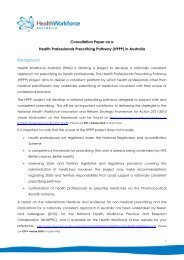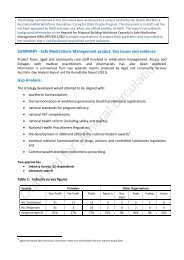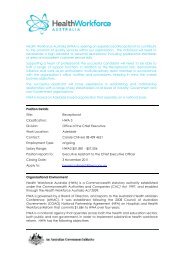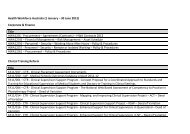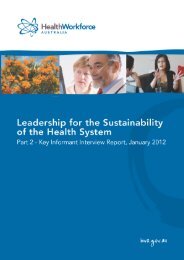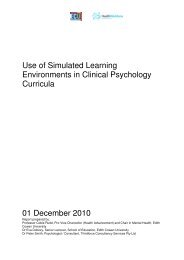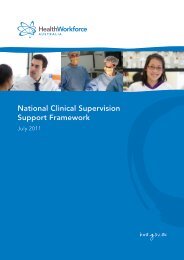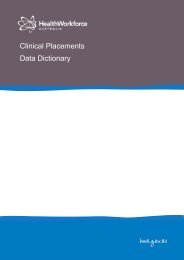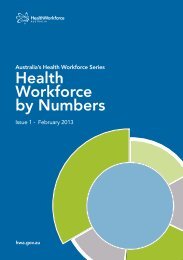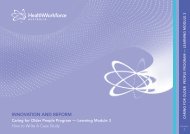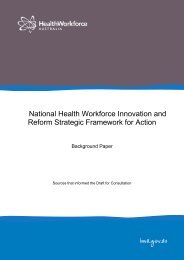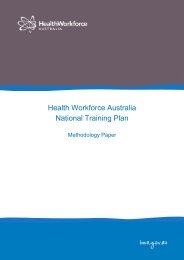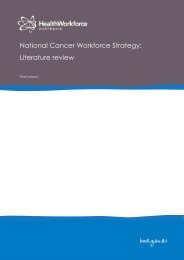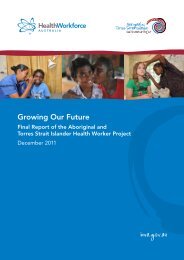Health Workforce Australia 2012-13 Work Plan
Health Workforce Australia 2012-13 Work Plan
Health Workforce Australia 2012-13 Work Plan
Create successful ePaper yourself
Turn your PDF publications into a flip-book with our unique Google optimized e-Paper software.
<strong>Health</strong> <strong><strong>Work</strong>force</strong> <strong>Australia</strong><br />
<strong>2012</strong>-<strong>13</strong> <strong>Work</strong> <strong>Plan</strong><br />
Final Version<br />
Approved by the Standing Council on <strong>Health</strong> 10 August <strong>2012</strong><br />
1
© <strong>Health</strong> <strong><strong>Work</strong>force</strong> <strong>Australia</strong><br />
This work is copyright. It may be reproduced in whole<br />
or part for study or training purposes only, provided<br />
that the acknowledgment below is included.<br />
Any reproduction for purposes other than those<br />
indicated above, or otherwise not in accordance with<br />
the provisions of the Copyright Act 1968 or any other<br />
legal obligation, requires the written permission of<br />
<strong>Health</strong> <strong><strong>Work</strong>force</strong> <strong>Australia</strong> (HWA).<br />
Enquiries<br />
Enquiries concerning this publication and its<br />
reproduction should be directed to:<br />
<strong>Health</strong> <strong><strong>Work</strong>force</strong> <strong>Australia</strong><br />
GPO Box 2098, Adelaide SA 5001<br />
T +61 8 8409 4500 F +61 8 8212 3841<br />
E hwa@hwa.gov.au<br />
www.hwa.gov.au<br />
ISBN: 978-0-9873201-4-8<br />
2
Table of<br />
Contents<br />
Background & Context 6<br />
Background 6<br />
Context 6<br />
1. National Partnership Agreement on Hospital<br />
and <strong>Health</strong> <strong><strong>Work</strong>force</strong> Reform 6<br />
2. <strong>Health</strong> <strong><strong>Work</strong>force</strong> 2025 - Doctors, Nurses and Midwives 6<br />
3. National <strong>Health</strong> <strong><strong>Work</strong>force</strong> Innovation and Reform<br />
Strategic Framework for Action 2011 - 2015 7<br />
Strategic Directions 9<br />
Goal 9<br />
Objectives 9<br />
1. Building capacity 9<br />
2. Boosting productivity 9<br />
3. Improving distribution 10<br />
How we work 10<br />
Who we work with 11<br />
<strong>2012</strong>-<strong>13</strong> Priorities 12<br />
Objective 1 - Building capacity 12<br />
Objective 2 - Boosting productivity 12<br />
Objective 3 - Improving distribution <strong>13</strong><br />
Building the evidence <strong>13</strong><br />
Providing leadership 14<br />
<strong>Work</strong>ing in collaboration 14<br />
<strong>2012</strong>-<strong>13</strong> <strong>Work</strong> <strong>Plan</strong> 15<br />
3
1 Building Capacity 16<br />
1.1 Clinical Training Funding Subsidy 16<br />
1.2 Simulated Learning Environments 17<br />
1.3 Clinical Supervision Support Program 19<br />
1.4 Integrated Regional Clinical Training Networks 21<br />
1.5 International <strong>Health</strong> Professionals - National Policy 23<br />
1.6 International <strong>Health</strong> Professionals -<br />
Pathways into Practice 24<br />
1.7 International <strong>Health</strong> Professionals -<br />
Attraction and Marketing 25<br />
1.8 National Medical Training Network -<br />
National Governance and Coordination<br />
of the Medical Training Pipeline 26<br />
1.9 Nursing - Retention, Training Capacity<br />
and Productivity 28<br />
1.10 <strong><strong>Work</strong>force</strong> Development -<br />
Program Integration and Sustainability 30<br />
1.11 Aboriginal and Torres Strait Islander <strong>Health</strong> <strong><strong>Work</strong>force</strong> 32<br />
2 Boosting Productivity 34<br />
2.1 Aged Care <strong><strong>Work</strong>force</strong> Reform 34<br />
2.2 <strong><strong>Work</strong>force</strong> Flexibility - Competency 35<br />
2.3 <strong><strong>Work</strong>force</strong> Flexibility - Assistant and Support Roles 36<br />
2.4 <strong><strong>Work</strong>force</strong> Flexibility - Expanding <strong><strong>Work</strong>force</strong><br />
Scope Initiatives 37<br />
4
3 Improving Distribution 38<br />
3.1 Geographical Distribution - Current Approaches,<br />
Future Policy and Program Options 38<br />
3.2 National Cancer <strong><strong>Work</strong>force</strong> Strategy 40<br />
3.3 National Rural and Remote <strong>Health</strong> <strong><strong>Work</strong>force</strong><br />
Innovation and Reform Strategy 41<br />
3.4 International <strong>Health</strong> Professionals -<br />
Retention and Deployment 42<br />
3.5 Rural Training Pathways 43<br />
How We <strong>Work</strong> 44<br />
Building the Evidence Base 44<br />
<strong>Health</strong> <strong><strong>Work</strong>force</strong> <strong>Plan</strong>ning 44<br />
<strong>Australia</strong>’s <strong>Health</strong> <strong><strong>Work</strong>force</strong> Series 46<br />
Statistical Resource and Data Collections 47<br />
Research Program 48<br />
Providing Leadership 49<br />
Leadership for Sustainable Change 49<br />
Promoting Public Debate 50<br />
<strong>Work</strong>ing in Collaboration 52<br />
Collaboration 52<br />
5
Background<br />
& Context<br />
Background<br />
<strong>Health</strong> <strong><strong>Work</strong>force</strong> <strong>Australia</strong> (HWA) was established as a national health workforce<br />
agency through the 2008 National Partnership Agreement on Hospital and<br />
<strong>Health</strong> <strong><strong>Work</strong>force</strong> Reform. HWA drives a strategic long-term program which<br />
addresses the future challenges of providing a skilled, flexible and innovative<br />
health workforce. The reforms are needed to address workforce shortages and<br />
to ensure <strong>Australia</strong>’s health workforce can meet increasing demands for services<br />
resulting from an ageing population, increasing levels of chronic disease and<br />
community expectations.<br />
Context<br />
Three policy foundations form the context for HWA’s work:<br />
1. National Partnership Agreement on Hospital and <strong>Health</strong><br />
<strong><strong>Work</strong>force</strong> Reform<br />
The National Partnership Agreement outlines the workforce reform initiatives<br />
agreed by governments to improve health workforce capacity, efficiency<br />
and productivity. These include funding, planning and coordinating clinical<br />
training across all health disciplines; supporting health workforce research<br />
and planning; improving international recruitment efforts; and progressing<br />
new workforce models and reforms.<br />
2. <strong>Health</strong> <strong><strong>Work</strong>force</strong> 2025 - Doctors, Nurses and Midwives<br />
<strong>Health</strong> <strong><strong>Work</strong>force</strong> 2025 - Doctors, Nurses and Midwives (HW 2025)<br />
provides long-term, national workforce projections and presents the best<br />
available planning information on <strong>Australia</strong>’s future health workforce. HW<br />
2025 finds that without nationally coordinated reform <strong>Australia</strong> is likely to<br />
experience limitations in the delivery of high quality health services. This is a<br />
consequence of workforce shortages and maldistribution, inefficiencies and<br />
insufficient capacity in the training system, and continued reliance on poorly<br />
coordinated skilled migration to meet essential workforce requirements.<br />
6
HW 2025 concludes that reform is essential and <strong>Australia</strong> cannot afford<br />
to continue business-as-usual approaches to work practices, productivity,<br />
training, geographical distribution and immigration. It is simply not tenable.<br />
It presents the case for essential coordinated, long-term reforms by<br />
government, professions and the higher education and training sector to<br />
secure a sustainable and affordable health workforce capable of maintaining<br />
high quality health care for <strong>Australia</strong>’s future.<br />
HW 2025 identifies a range of policy directions covering workforce reform,<br />
training, immigration and geographical distribution that can be adopted to<br />
deliver a more sustainable health workforce.<br />
The findings of HW 2025 provide a key focus for HWA’s work and will have<br />
an enduring influence on HWA’s work plan. It will be updated with new data,<br />
and future iterations will include allied health professions, oral health and key<br />
service domains.<br />
3. National <strong>Health</strong> <strong><strong>Work</strong>force</strong> Innovation and Reform Strategic<br />
Framework for Action 2011 - 2015<br />
The National <strong>Health</strong> <strong><strong>Work</strong>force</strong> Innovation and Reform Strategic Framework<br />
for Action 2011 - 2015 has been approved by <strong>Health</strong> Ministers and provides<br />
an overarching, national platform to guide health workforce reform. HWA<br />
aligns all of its programs and initiatives with the five domains for action<br />
identified in the Framework. The five domains are the essential areas of<br />
activity for development of a sustainable health workforce for the future.<br />
HWA is focused on driving national workforce reform through a suite of<br />
programs and measures. HWA works in partnership with governments,<br />
higher education, the training sector, employers, professions and regulatory<br />
bodies to progress its work programs.<br />
Much of the essential reform enablers require action under Domain<br />
5 - <strong>Health</strong> workforce policy, funding and regulations. This is the core<br />
responsibility of governments and regulatory bodies.<br />
The domains and their objectives are outlined in Figure 1 on page 8.<br />
BACKGROUND<br />
7
Figure 1. National <strong>Health</strong> <strong><strong>Work</strong>force</strong> Innovation and Reform Strategic Framework<br />
for Action 2011 - 2015 domains and objectives<br />
KEY DOMAINS<br />
OBJECTIVES<br />
1. HEALTH WORKFORCE REFORM FOR<br />
MORE EFFECTIVE, EFFICIENT AND<br />
ACCESSIBLE SERVICE DELIVERY<br />
Reform health workforce roles to improve<br />
productivity and support more effective,<br />
efficient and accessible service delivery models<br />
that better address population health needs<br />
2. HEALTH WORKFORCE CAPACITY AND<br />
SKILLS DEVELOPMENT<br />
Develop an adaptable health workforce<br />
equipped with the requisite competencies<br />
and support that provides team-based and<br />
collaborative models of care<br />
3. LEADERSHIP FOR THE<br />
SUSTAINABILITY OF THE<br />
HEALTH SYSTEM<br />
Develop leadership capacity to support and<br />
lead health workforce innovation and reform.<br />
4. HEALTH WORKFORCE PLANNING<br />
Enhance workforce planning capacity, both<br />
nationally and jurisdictionally, taking account<br />
of emerging health workforce configuration,<br />
technology and competencies.<br />
5. HEALTH WORKFORCE POLICY,<br />
FUNDING AND REGULATION<br />
Develop policy, regulation, funding and<br />
employment arrangements that are supportive<br />
of health workforce reform.<br />
8
Strategic Directions<br />
Goal<br />
To build a sustainable health workforce for <strong>Australia</strong>.<br />
Objectives<br />
In order to meet this goal HWA’s work plan is driven by three core objectives:<br />
1. Building capacity<br />
Building capacity by delivering more workforce, fit for purpose, more quickly<br />
and efficiently.<br />
Strategies to meet this objective include:<br />
Creating a more efficient training system.<br />
Creating a more efficient migration pathway.<br />
Creating a nationally coordinated approach to retention.<br />
2. Boosting productivity<br />
Boosting the productivity of the workforce and maximising the utility of the<br />
workforce.<br />
Strategies to meet this objective include:<br />
Delivering a cost efficient health workforce that is skilled and flexible.<br />
Maximising the potential of the health professional workforce to work at<br />
the top of their license.<br />
Building an appropriate, skilled assistant and support workforce to boost<br />
productivity and flexibility.<br />
Fostering nationally scalable health workforce innovation including<br />
new workforce models.<br />
9
3. Improving distribution<br />
Getting the workforce in the places they are needed.<br />
Strategies to meet this objective include:<br />
Supporting a more balanced health workforce profile across professions<br />
and specialties to meet health service needs, including a focus on<br />
generalist skills.<br />
Facilitating a more equitable geographic distribution of the health<br />
workforce.<br />
How we<br />
work<br />
To deliver the three objectives and help drive health workforce reform nationally,<br />
HWA works in the following ways:<br />
Building the evidence - Providing the evidence base for health workforce<br />
reform through planning, research and evaluation to inform key directions for<br />
national health workforce reform and innovation.<br />
Providing leadership - Providing policy advice and leadership to inform and<br />
influence national policy and program decisions in relation to health workforce<br />
innovation and reform.<br />
<strong>Work</strong>ing in collaboration - <strong>Work</strong>ing with key stakeholders to deliver targeted<br />
programs to drive reform. Providing information, guidance and support to<br />
assist governments, policy makers and key decision-makers to deliver the<br />
necessary legislative, funding and regulatory reform required to support a<br />
sustainable health workforce.<br />
This is illustrated in Figure 2.<br />
PRODUCTIVITY<br />
A SUSTAINABLE<br />
HEALTH<br />
WORKFORCE<br />
FOR AUSTRALIA<br />
CAPACITY<br />
DISTRIBUTION<br />
Building<br />
the Evidence<br />
Providing<br />
Leadership<br />
<strong>Work</strong>ing<br />
in Collaboration<br />
Figure 2. HWA Strategic Directions<br />
10
Who we<br />
work with<br />
HWA provides funding to deliver and support implementation of a wide range of<br />
health reform initiatives. These funding programs form only one part of the story.<br />
To deliver national reform to achieve a sustainable health workforce for the future<br />
it is necessary for the full array of stakeholders to work together to provide the<br />
necessary changes required to deliver and support sustainable reform. This<br />
requires work by governments, regulatory, funding and policy bodies, and is<br />
why the National <strong>Health</strong> <strong><strong>Work</strong>force</strong> Innovation and Reform Strategic Framework<br />
for Action 2011-2015 is a key policy guide for the health sector. The Framework<br />
provides a national approach to guide all stakeholders in their actions to support<br />
the changes necessary to drive essential workforce reform.<br />
In delivering HWA funded programs and more broadly, in helping to drive and<br />
support the necessary changes to support national reform, HWA works with a<br />
wide range of stakeholders including:<br />
Commonwealth, State, Territory and Local Governments<br />
<strong>Health</strong> service providers<br />
Employers<br />
Private and non-government sector<br />
Higher education sector<br />
Training sector<br />
<strong>Health</strong> professional bodies, colleges and associations<br />
<strong>Health</strong> professional registration and accreditation agencies<br />
National agencies focused on health reform, information, efficiency, equity,<br />
quality and safety<br />
Peak bodies<br />
<strong>Health</strong> advocacy bodies<br />
Consumers<br />
Unions<br />
Student and trainee workforce<br />
11
<strong>2012</strong>-<strong>13</strong> <strong>Work</strong> <strong>Plan</strong><br />
Priorities<br />
<strong>2012</strong>-<strong>13</strong><br />
Priorities<br />
In <strong>2012</strong>-<strong>13</strong> HWA will deliver the following major programs:<br />
Objective 1 - Building capacity<br />
The outcome sought by activity undertaken under this objective is to increase<br />
the capacity of the training system and to streamline the process for international<br />
health professionals to enable a more efficient process from attraction through to<br />
retention.<br />
Supporting the delivery of more health professionals into the workforce<br />
by providing a funding subsidy to support growth and efficiency in clinical<br />
training, and funding for the establishment of infrastructure to provide greater<br />
training capacity.<br />
Boosting the efficiency of training through improved quality and consistency<br />
of clinical supervision and fostering innovative training methods such as<br />
simulation and on-line learning to enhance existing modalities.<br />
Supporting a more streamlined approach to the attraction, registration and<br />
retention of international health professionals.<br />
Devising policy and program measures to develop more efficient and<br />
coordinated training pathways.<br />
Undertaking research and policy development to consolidate evidence on<br />
retention and attraction, including an assessment of the effectiveness of<br />
current policy measures.<br />
Objective 2 - Boosting productivity<br />
The outcome sought by activity under this objective is to progress workforce<br />
reform on a more systematic and larger scale. The work program provides for the<br />
demonstration of successful targeted programs which have potential for national<br />
implementation.<br />
12
These projects will identify what works and identify the requirements for national<br />
implementation.<br />
Implementing new workforce models and expanded scopes of practice for<br />
health professionals to enable them to work at the top of their licence.<br />
Development of new support and assistant roles to enable more efficient<br />
utilisation of the health workforce.<br />
Supporting the delivery of a more flexible workforce with a specific focus on<br />
priority areas including aged care, Aboriginal and Torres Strait Islander health,<br />
cancer and rural and remote services.<br />
Addressing leadership capability and skills to ensure the delivery of innovation<br />
and reform.<br />
Objective 3 - Improving distribution<br />
The outcome sought by activity under this objective is to implement programs<br />
that will contribute to improved distribution of the health workforce and identify<br />
national policy levers and opportunities that will provide for a sustainable and<br />
equitable distribution of the health workforce.<br />
Implementing the National Rural and Remote <strong>Health</strong> <strong><strong>Work</strong>force</strong> Innovation &<br />
Reform Strategy and the National Cancer <strong><strong>Work</strong>force</strong> Strategy.<br />
Implementing the International <strong>Health</strong> Professionals Program, which includes<br />
the Rural <strong>Health</strong> Professionals Program, expansion of <strong>Work</strong> Place Based<br />
Assessments, national marketing of international recruitment, and reducing<br />
red tape.<br />
Supporting the ongoing development of programs to address the balance of<br />
generalists and specialists in the health workforce.<br />
Evaluating the effectiveness of current measures and developing policy<br />
options to achieve improved distribution of health professionals.<br />
Building the evidence<br />
Developing the National Statistical Resource.<br />
Undertaking supply and demand modelling for selected allied health<br />
professionals to 2025, and targeted services groups such as oral health and<br />
mental health.<br />
Informing the sector by publishing health workforce data and reports,<br />
including Nurses In Focus and Clinical Training In Focus.<br />
<strong>2012</strong>-<strong>13</strong> PRIORITIES<br />
<strong>13</strong>
Delivering a research program to inform the development of <strong>Australia</strong>’s health<br />
workforce. <strong>2012</strong>-<strong>13</strong> research themes are: understanding rural health workforce<br />
issues; evaluating workforce reform and innovation, and measuring and<br />
costing clinical teaching and training.<br />
Developing an evaluation method to assess the applicability of local<br />
innovations for national implementation.<br />
Providing leadership<br />
Fostering national debate and decision making on health workforce reform<br />
matters across the health, education and training sectors.<br />
Implementing a national engagement program across health workforce<br />
leaders and stakeholders to drive innovation and reform responses to HW<br />
2025.<br />
Convening the HWA National Conference in November <strong>2012</strong>, which will<br />
provide a national focus and leadership in health workforce reform and<br />
innovation.<br />
Supporting the Future <strong>Health</strong> Leaders Council including a national conference<br />
for students and early career professionals.<br />
<strong>Work</strong>ing in collaboration<br />
Systematically engaging with the <strong>Australia</strong>n <strong>Health</strong> Ministers’ Advisory Council<br />
and the Standing Council on <strong>Health</strong> to ensure alignment of HWA’s work program<br />
with national reform directions and the provision of policy advice as required.<br />
Establishing and maintaining formal engagement and relationships with<br />
relevant organisations to progress national health workforce reform.<br />
Developing international partnership opportunities with like workforce<br />
agencies.<br />
Engaging with workforce stakeholders through effective project<br />
governance, Standing Advisory Committees and Integrated Regional<br />
Clinical Training Networks.<br />
14
<strong>2012</strong>-<strong>13</strong> <strong>Work</strong> <strong>Plan</strong><br />
The following section provides a detailed list and description of the HWA<br />
program initiatives. For each program a summary of the purpose, a general<br />
description and a list of output measures is provided. For each program the key<br />
domains it relates to, from the National <strong>Health</strong> <strong><strong>Work</strong>force</strong> Innovation and Reform<br />
Strategic Framework for Action 2011-2015, are also identified.<br />
To assist understanding of how the programs relate to the core objectives of<br />
Capacity, Productivity and Distribution the icons are displayed for each program.<br />
The primary focus of the program is identified through the use of the appropriate<br />
coloured icon. A grey scale icon indicates that the program has a secondary<br />
impact on one or more of the other objectives.<br />
<strong>2012</strong>-<strong>13</strong> PRIORITIES<br />
15
1 Building Capacity<br />
1.1 Clinical Training Funding Subsidy<br />
Purpose<br />
To increase the capacity of the health system by supporting growth in clinical<br />
training places for health professional students.<br />
Key activities<br />
The key activities to be undertaken in <strong>2012</strong>-<strong>13</strong> include:<br />
Providing recurrent funding to higher education, government and nongovernment<br />
health providers to subsidise clinical placement growth from<br />
2011- 20<strong>13</strong>.<br />
Providing one-off capital and establishment funding to higher education,<br />
government and non-government health providers to develop infrastructure to<br />
support growth in clinical training activity.<br />
Output measure(s)<br />
Growth in baseline of commencing students across the funded professions.<br />
Growth in clinical training days across targeted settings and professions.<br />
National <strong>Health</strong><br />
<strong><strong>Work</strong>force</strong><br />
Innovation &<br />
Reform Strategic<br />
Framework for<br />
Action - Domains<br />
Domain 2 - <strong>Health</strong> workforce capacity and skills development<br />
1.1 CLINICAL TRAINING FUNDING SUBSIDY<br />
16
1. BUILDING CAPACITY<br />
1.2 Simulated Learning<br />
Environments<br />
Purpose<br />
To increase the capacity and efficiency of the training system through the use<br />
of simulated learning methodologies in clinical training. This measure will also<br />
increase equity of access for students to simulated educational experiences in<br />
regional, rural and remote settings.<br />
Key activities<br />
The key activities to be undertaken in <strong>2012</strong>-<strong>13</strong> include:<br />
Program Responses<br />
Progressing jurisdictional Simulated Learning Environments (SLE) projects in<br />
public, education, private and non-government organisation sectors.<br />
Developing and implementing projects to embed simulation in clinical training<br />
in a range of health professions.<br />
Developing and implementing a model of using virtual world technology to<br />
improve clinical training capacity for professional entry students, focusing on<br />
communication and professional practice.<br />
Enabling<br />
Implementing a national simulation educator and technician/coordinator<br />
training package to train up to 6,000 individuals.<br />
Developing and implementing a national simulation e-portal to provide a<br />
network for simulation professionals and a case-bank of simulation material for<br />
the purposes of promoting interprofessional collaboration and resource sharing<br />
within <strong>Australia</strong>’s health workforce.<br />
Developing a costing model for simulation education and training.<br />
Developing a model of accreditation of SLE programs in the <strong>Australia</strong>n setting.<br />
Developing and implementing a national directory of SLE providers and<br />
programs.<br />
1.2 SIMULATED LEARNING ENVIRONMENTS<br />
17
1. BUILDING CAPACITY<br />
Key activities<br />
Evidence<br />
Undertaking a research program on the cost effectiveness of simulation versus<br />
other clinical training modalities.<br />
Completing SLE curricular reports addressing the use of SLE in all health<br />
professional disciplines.<br />
Developing, implementing and evaluating models of distributed simulation<br />
to increase access to SLEs for professional entry students training in rural and<br />
remote areas.<br />
Developing and implementing a model of certification within <strong>Australia</strong> to<br />
include SLE educators working in the healthcare sector.<br />
Output measure(s)<br />
Number of curriculum projects complete.<br />
Number of enabling projects complete.<br />
Number of embedding projects complete.<br />
Extent of expanded simulation activity attributable to the programs.<br />
National <strong>Health</strong><br />
<strong><strong>Work</strong>force</strong><br />
Innovation &<br />
Reform Strategic<br />
Framework for<br />
Action - Domains<br />
Domain 2 - <strong>Health</strong> workforce capacity and skills development<br />
Domain 5 - <strong>Health</strong> workforce policy, funding and regulation<br />
1.2 SIMULATED LEARNING ENVIRONMENTS<br />
18
1. BUILDING CAPACITY<br />
1.3 Clinical Supervision<br />
Support Program<br />
Purpose<br />
To improve the capacity of the training system by expanding clinical supervision<br />
capacity and competence across the higher educational and training continuum<br />
through measures to support and develop a competent clinical supervision<br />
workforce, which delivers quality clinical training.<br />
Key activities<br />
The key activities to be undertaken in <strong>2012</strong>-<strong>13</strong> include:<br />
Delivering Clinical Supervision Support Program initiatives through Integrated<br />
Regional Clinical Training Networks (IRCTNs) to promote continuous<br />
improvement and innovation in clinical supervision. This will include a grants<br />
funding program to support proposals facilitated by IRCTNs.<br />
Defining roles, responsibilities and accountabilities of key stakeholders involved<br />
in the delivery of clinical training and supervision.<br />
Embedding clinical education and training principles, as defined in the<br />
National Clinical Supervision Support Framework, through incorporation in<br />
documentation and practice.<br />
Improving the quality of clinical supervision at organisation, service and clinical<br />
supervisor levels.<br />
Developing a National Competency Framework for Clinical Supervision,<br />
including guidelines for intra-professional and interprofessional learning and<br />
practice.<br />
Implementing projects focused on Models of Clinical Supervision for<br />
Medicine - coordinated national approach to medical supervision, and Allied<br />
<strong>Health</strong> - a targeted national approach for professionals who have limited<br />
access to training<br />
1.3 CLINICAL SUPERVISION SUPPORT PROGRAM<br />
19
1. BUILDING CAPACITY<br />
Key activities<br />
Improving coordination and consistency of supervision approaches across<br />
higher education and clinical training providers.<br />
Developing discipline specific competency based clinical placement<br />
assessment tools for a number of professions.<br />
Developing guidelines based on best practice for clinical placement<br />
agreements and student placement documentation.<br />
Enhancing clinical supervision capacity in the health system.<br />
Implementing a national recognition program for excellence in clinical<br />
supervision.<br />
Identifying elements to promote quality learning experiences for health<br />
profession students.<br />
Developing an online platform for clinical supervision.<br />
Output measure(s)<br />
Number of clinical supervisor training programs delivered and total number of<br />
participants.<br />
Number of projects completed.<br />
National <strong>Health</strong><br />
<strong><strong>Work</strong>force</strong><br />
Innovation &<br />
Reform Strategic<br />
Framework for<br />
Action - Domains<br />
Domain 2 - <strong>Health</strong> workforce capacity and skills development<br />
1.3 CLINICAL SUPERVISION SUPPORT PROGRAM<br />
20
1. BUILDING CAPACITY<br />
1.4 Integrated Regional Clinical<br />
Training Networks<br />
Purpose<br />
To increase the capacity of the training system by supporting the operation<br />
of Integrated Regional Clinical Training Networks (IRCTNs) across States and<br />
Territories, to facilitate coordination, planning and delivery of quality clinical<br />
training activity across the health sector, including public and non government<br />
health providers and higher education and training providers.<br />
Key activities<br />
The key activities to be undertaken in <strong>2012</strong>-<strong>13</strong> include funding and supporting<br />
the IRCTNs to:<br />
Promote access to clinical training placements opportunities i.e. network<br />
profiling to determine available placement types and number.<br />
Report on clinical training activity key performance indicators (KPIs).<br />
Build relationships and collaborations between higher education and<br />
government and non-government clinical training providers to source new<br />
clinical placement settings and opportunities, facilitate practical solutions to<br />
barriers, and auspice innovative projects within and across IRCTNs.<br />
Undertake planning and deployment of training requirements and placement<br />
opportunities i.e. monitoring and addressing local workforce needs to better<br />
inform training efforts.<br />
Match supply and demand for placements and recommend distribution<br />
accordingly by facilitating planning and negotiation processes for clinical<br />
placements.<br />
Support higher education and training providers and government and nongovernment<br />
employers in the management of clinical placements including at<br />
the local level.<br />
Support and engage with higher education and government and non<br />
government clinical training providers on other key national workforce reform<br />
issues consistent with the National Partnership Agreement.<br />
1.4 INTEGRATED REGIONAL CLINICAL TRAINING NETWORKS<br />
21
1. BUILDING CAPACITY<br />
Output measure(s)<br />
Systematic reporting from IRCTNs on supply and demand for clinical training<br />
places by profession across the state or territory.<br />
Growth in clinical training placements, including growth in new settings.<br />
Engagement of all sectors in the planning and delivery of clinical training<br />
through IRCTNs.<br />
Facilitation and support of workforce reform by IRCTNs.<br />
National <strong>Health</strong><br />
<strong><strong>Work</strong>force</strong><br />
Innovation &<br />
Reform Strategic<br />
Framework for<br />
Action - Domains<br />
Domain 2 - <strong>Health</strong> workforce capacity and skills development<br />
1.4 INTEGRATED REGIONAL CLINICAL TRAINING NETWORKS<br />
22
1. BUILDING CAPACITY<br />
1.5 International <strong>Health</strong> Professionals<br />
- National Policy<br />
Purpose<br />
To identify potential opportunities to improve the efficiency and effectiveness<br />
of international health professional migration.<br />
Key activities<br />
The key activities to be undertaken in <strong>2012</strong>-<strong>13</strong> include:<br />
Scoping <strong>Australia</strong>n health sector international recruitment activity.<br />
Reviewing pathways to practice for international health professionals.<br />
Analysing international health labour market trends (push/pull factors).<br />
Output measure(s)<br />
Identification of opportunities to improve and streamline the pathway for<br />
practice for international health professionals.<br />
Identification of more effective and efficient approaches for the attraction and<br />
deployment of international health professionals.<br />
National <strong>Health</strong><br />
<strong><strong>Work</strong>force</strong><br />
Innovation &<br />
Reform Strategic<br />
Framework for<br />
Action - Domains<br />
Domain 1 - <strong>Health</strong> workforce reform for more effective, efficient and accessible<br />
service delivery<br />
Domain 2 - <strong>Health</strong> workforce capacity and skills development<br />
Domain 5 - <strong>Health</strong> workforce policy, funding and regulation<br />
1.5 INTERNATIONAL HEALTH PROFESSIONALS - NATIONAL POLICY<br />
23
1. BUILDING CAPACITY<br />
1.6 International <strong>Health</strong> Professionals<br />
- Pathways into Practice<br />
Purpose<br />
To increase the capacity of the workforce by streamlining and creating a more<br />
efficient pathway into practice for international health professionals.<br />
Key activities<br />
The key activities to be undertaken in <strong>2012</strong>-<strong>13</strong> include:<br />
Streamlining the pathway to practice for international health professionals.<br />
Supporting coordinated and consistent approaches to the orientation of<br />
international health professionals to the <strong>Australia</strong>n health system.<br />
Delivering programs that provide quality integration into practice.<br />
Expanding work place based assessment programs.<br />
Output measure(s)<br />
Expanded <strong>Work</strong> Place Based Assessment Program.<br />
Coordination of delivery of orientation programs.<br />
National <strong>Health</strong><br />
<strong><strong>Work</strong>force</strong><br />
Innovation &<br />
Reform Strategic<br />
Framework for<br />
Action - Domains<br />
Domain 2 - <strong>Health</strong> workforce capacity and skills development<br />
Domain 5 - <strong>Health</strong> workforce policy, funding and regulation<br />
1.6 INTERNATIONAL HEALTH PROFESSIONALS - PATHWAYS INTO PRACTICE<br />
24
1. BUILDING CAPACITY<br />
1.7 International <strong>Health</strong> Professionals<br />
- Attraction and Marketing<br />
Purpose<br />
To increase the capacity of the health workforce by streamlining and<br />
coordinating international health professional attraction and marketing.<br />
Key activities<br />
The key activities to be undertaken in <strong>2012</strong>-<strong>13</strong> include:<br />
Coordinating the management of international attraction and marketing events.<br />
Assisting international health professionals to access timely and accurate advice<br />
about living and working in <strong>Australia</strong>.<br />
Output measure(s)<br />
Development of a marketing and branding strategy for <strong>Australia</strong> for the<br />
recruitment of international health professionals.<br />
Development and implementation of a coordinated attraction program for<br />
international health professionals.<br />
Establishment of an international health labour market presence for <strong>Australia</strong><br />
through the use of a single portal and national branding initiative.<br />
National <strong>Health</strong><br />
<strong><strong>Work</strong>force</strong><br />
Innovation &<br />
Reform Strategic<br />
Framework for<br />
Action - Domains<br />
Domain 2 - <strong>Health</strong> workforce capacity and skills development<br />
Domain 5 - <strong>Health</strong> workforce policy, funding and regulation<br />
1.7 INTERNATIONAL HEALTH PROFESSIONALS - ATTRACTION AND MARKETING<br />
25
1. BUILDING CAPACITY<br />
1.8 National Medical Training<br />
Network - National Governance<br />
and Coordination of the Medical<br />
Training Pipeline<br />
Purpose<br />
To build workforce capacity and improve geographical distribution of the<br />
medical workforce through establishment of a National Medical Training<br />
Network to enhance planning, coordination and governance of medical training<br />
from professional entry through to vocational training. This is consistent with<br />
HW 2025 findings regarding better national organisation of the training pipeline<br />
for doctors, and recognises the need to balance the local training and service<br />
requirements of jurisdictions with the management of medical training as a<br />
national resource.<br />
Key activities<br />
In <strong>2012</strong>-<strong>13</strong> HWA will establish a National Medical Training Network to:<br />
Align overall national medical training effort to agreed national medical<br />
workforce planning parameters.<br />
Facilitate equitable geographical distribution of appropriately accredited<br />
training places according to need.<br />
Monitor performance of the national medical training system.<br />
Inform medical workforce planning and training program developments<br />
undertaken by HWA, Commonwealth, State/Territory Governments, Colleges,<br />
GPET, Higher education sector, employers, Medicare Locals and clinical training<br />
providers.<br />
Support the work of the IRCTNs to coordinate regional, state and national<br />
planning.<br />
Facilitate national consistency in approaches to clinical supervision and training<br />
reforms.<br />
Establish a profile of current and potential accredited training places occupied<br />
by international medical graduates to provide guidance on national medical<br />
immigration requirements.<br />
1.8 NATIONAL MEDICAL TRAINING NETWORK - NATIONAL GOVERNANCE...<br />
26
1. BUILDING CAPACITY<br />
Output measure(s)<br />
Five Year National Training <strong>Plan</strong> for doctors - professional entry through to<br />
post graduate training.<br />
State and regional training plans for doctors linked to the Five Year National<br />
Training <strong>Plan</strong>.<br />
Annual estimates of intakes and program adjustments needed to meet<br />
agreed national workforce planning parameters - for Universities, Colleges,<br />
Government, GPET, DIISRTE.<br />
Annual report of performance on national training effort.<br />
National <strong>Health</strong><br />
<strong><strong>Work</strong>force</strong><br />
Innovation &<br />
Reform Strategic<br />
Framework for<br />
Action - Domains<br />
Domain 2 - <strong>Health</strong> workforce capacity and skills development<br />
Domain 4 - <strong>Health</strong> workforce planning<br />
1.8 NATIONAL MEDICAL TRAINING NETWORK - NATIONAL GOVERNANCE...<br />
27
1. BUILDING CAPACITY<br />
1.9 Nursing - Retention, Training<br />
Capacity and Productivity<br />
Purpose<br />
HW 2025 findings identify retention of nurses in the workforce as the most<br />
significant factor in reducing the projected gap between supply and demand<br />
for nurses. This project will focus on workplace, employer and training<br />
responses to nursing retention and reform, inclusive of approaches to<br />
leadership and management, industrial relations practice and KPIs, as well as<br />
examining attraction of early career graduates.<br />
This work will complement other HWA projects which target factors impacting<br />
on nurse retention and training reform (see under Productivity). It will identify<br />
workplace, industrial and management practices from the literature (e.g.<br />
Magnet Hospitals) proven to be positively correlated with nurse retention, and<br />
assess their current state of uptake and adoption across the health sector. It will<br />
also identify potential KPIs of best practice and propose training reforms which<br />
could be incorporated into HWA’s suite of clinical training reform programs.<br />
Key activities<br />
The key activities to be undertaken in <strong>2012</strong>-<strong>13</strong> include:<br />
Reviewing literature for best practice in nursing retention relevant to workplace,<br />
employer, industrial and training practice.<br />
Analysing uptake and adoption rates of evidence based best practice<br />
approaches to retention of nurses across <strong>Australia</strong> by sector and what works in<br />
relation to attraction for early career graduates.<br />
Identifying KPIs of best practice retention at enterprise and sector level.<br />
Identifying management, regulatory and industrial barriers and enablers to<br />
adoption of best practice in retention.<br />
Developing reform options, inclusive of high level economic analysis, for<br />
consideration by governments, higher education sector, employer and<br />
professions.<br />
1.9 NURSING - RETENTION, TRAINING CAPACITY AND PRODUCTIVITY<br />
28
1. BUILDING CAPACITY<br />
Output measure(s)<br />
Report on current status of adoption of proven best practice approaches to<br />
nurse retention across <strong>Australia</strong>, and reform options to enhance uptake.<br />
Development of a core set of KPIs for nurse retention.<br />
Identifying recommendations to address program improvements.<br />
Implementation <strong>Plan</strong> to address high priority evidence based nursing retention<br />
strategies.<br />
National <strong>Health</strong><br />
<strong><strong>Work</strong>force</strong><br />
Innovation &<br />
Reform Strategic<br />
Framework for<br />
Action - Domains<br />
Domain 1 - <strong>Health</strong> workforce reform for more effective, efficient and accessible<br />
service delivery<br />
Domain 2 - <strong>Health</strong> workforce capacity and skills development<br />
Domain 3 - Leadership for the sustainability of the health system<br />
Domain 5 - <strong>Health</strong> workforce policy, funding and regulation<br />
1.9 NURSING - RETENTION, TRAINING CAPACITY AND PRODUCTIVITY<br />
29
1. BUILDING CAPACITY<br />
1.10 <strong><strong>Work</strong>force</strong> Development<br />
- Program Integration and<br />
Sustainability<br />
Purpose<br />
To map and identify the range of targeted health workforce development<br />
programs funded and implemented across the Commonwealth, State and<br />
Territory Governments and assess their alignment with priority reform directions<br />
identified in the HW 2025 and the National <strong>Health</strong> <strong><strong>Work</strong>force</strong> Innovation &<br />
Reform Strategic Framework for Action 2011-2015.<br />
<strong>Health</strong> workforce development programs have been developed progressively<br />
at the Commonwealth, State and Territory government levels over several years.<br />
The programs have responded to successive issues over several years, in the<br />
absence of an overarching planning framework and national policy framework<br />
for coordinated national action.<br />
All governments have agreed to move to national activity based funding<br />
models for public hospital services, including teaching and training, with<br />
the Independent Hospital Pricing Authority (IHPA) to establish a national<br />
efficient pricing mechanism for such activity by 2018. This will enable greater<br />
transparency and accountability for outputs and outcomes in clinical training.<br />
The modern health workforce is not confined by jurisdictional, sectoral and<br />
national boundaries. Programs targeting its planning and development need<br />
to be considered in this light. With the advent of HW 2025, the National <strong>Health</strong><br />
<strong><strong>Work</strong>force</strong> Innovation & Reform Strategic Framework for Action 2011-2015<br />
and the emergence of activity based funding for aspects of <strong>Australia</strong>’s health<br />
workforce development it is appropriate to consider alignment of current<br />
targeted workforce programs with these key national foundations and their<br />
sustainability into the future.<br />
Key activities<br />
The key activities to be undertaken in <strong>2012</strong>-<strong>13</strong> include:<br />
Mapping the current range of national, state and territory health workforce<br />
development programs<br />
Assessing alignment of effort in these programs against HW 2025, and the<br />
National <strong>Health</strong> <strong><strong>Work</strong>force</strong> Innovation & Reform Strategic Framework for<br />
Action 2011-2015.<br />
Making recommendations to improve the alignment and targeting of programs<br />
against agreed priorities.<br />
1.10 WORKFORCE DEVELOPMENT - PROGRAM INTEGRATION AND SUSTAINABILITY<br />
30
1. BUILDING CAPACITY<br />
Output measure(s)<br />
Report on current program alignment and recommendations to enhance<br />
national coordination and alignment of targeted workforce programs to HW<br />
2025 and the National <strong>Health</strong> <strong><strong>Work</strong>force</strong> Innovation & Reform Strategic<br />
Framework for Action 2011-2015.<br />
Annual reporting to <strong>Health</strong> Ministers on activity under the National <strong>Health</strong><br />
<strong><strong>Work</strong>force</strong> Innovation & Reform Strategic Framework for Action 2011-2015<br />
and HW 2025 implementation efforts.<br />
National <strong>Health</strong><br />
<strong><strong>Work</strong>force</strong><br />
Innovation &<br />
Reform Strategic<br />
Framework for<br />
Action - Domains<br />
Domain 5 - <strong>Health</strong> workforce policy, funding and regulation<br />
1.10 WORKFORCE DEVELOPMENT - PROGRAM INTEGRATION AND SUSTAINABILITY<br />
31
1. BUILDING CAPACITY<br />
1.11 Aboriginal and Torres Strait<br />
Islander <strong>Health</strong> <strong><strong>Work</strong>force</strong><br />
Purpose<br />
To increase the capacity of the Aboriginal and Torres Strait Islander health<br />
workforce, especially Aboriginal and Torres Strait Islander <strong>Health</strong> <strong>Work</strong>ers/<br />
Practitioners. This work will support the recommendations of the final report<br />
of the Aboriginal and Torres Strait Islander <strong>Health</strong> <strong>Work</strong>er project.<br />
This work also supports and contributes to the workforce targets under the<br />
2008 COAG National Partnership Agreement on Closing the Gap in Indigenous<br />
<strong>Health</strong> Outcomes.<br />
Key activities<br />
The key activities to be undertaken in <strong>2012</strong>-<strong>13</strong> include:<br />
Developing an Implementation <strong>Plan</strong> for the recommendations of the Final<br />
Report of the Aboriginal and Torres Strait Islander <strong>Health</strong> <strong>Work</strong>er project.<br />
Reviewing and updating the national Aboriginal and Torres Strait Islander<br />
Primary <strong>Health</strong> Care Training Package.<br />
Undertaking skill recognition and upskilling for Aboriginal and/or Torres Strait<br />
Islander <strong>Health</strong> <strong>Work</strong>ers to meet national registration requirements.<br />
Reviewing and updating a Clinical Log Book for Aboriginal and Torres Strait<br />
Islander <strong>Health</strong> <strong>Work</strong>ers as a competency based assessment tool.<br />
Developing a multimedia resource to promote awareness and respect of the<br />
significant role of Aboriginal and Torres Strait Islander <strong>Health</strong> <strong>Work</strong>ers.<br />
Developing a culturally inclusive, interdisciplinary Aboriginal and Torres Strait<br />
Islander health curriculum framework for implementation in health professional<br />
education courses.<br />
Output measure(s)<br />
Development of national training program for Aboriginal and Torres Strait<br />
Islander <strong>Health</strong> <strong>Work</strong>ers to support national registration of Aboriginal and<br />
Torres Strait Islander <strong>Health</strong> Practitioners from July <strong>2012</strong>.<br />
Development of a culturally inclusive, interdisciplinary Aboriginal and Torres<br />
Strait Islander health curriculum framework to be integrated into entry level<br />
health profession training.<br />
1.11 ABORIGINAL AND TORRES STRAIT ISLANDER HEALTH WORKFORCE<br />
32
1. BUILDING CAPACITY<br />
National <strong>Health</strong><br />
<strong><strong>Work</strong>force</strong><br />
Innovation &<br />
Reform Strategic<br />
Framework for<br />
Action - Domains<br />
Domain 1 - <strong>Health</strong> workforce reform for more effective, efficient and accessible<br />
service delivery<br />
Domain 2 - <strong>Health</strong> workforce capacity and skills development<br />
Domain 3 - Leadership for the sustainability of the health system<br />
Domain 5 - <strong>Health</strong> workforce policy, funding and regulation<br />
1.11 ABORIGINAL AND TORRES STRAIT ISLANDER HEALTH WORKFORCE<br />
33
2 Boosting Productivity<br />
2.1 Aged Care <strong><strong>Work</strong>force</strong><br />
Reform<br />
Purpose<br />
To increase productivity and flexibility of the aged care workforce through<br />
implementation of new workforce models. Specific focus will be on the<br />
development of the support and assistant workforce, generalist roles, and<br />
expanded scope of practice for complex care.<br />
Key activities The key activities to be undertaken in <strong>2012</strong>-<strong>13</strong> include funding up to 30<br />
workforce projects to:<br />
Explore various scopes of practice and workforce redesign to optimise current<br />
workforce skills and adaptability within aged care.<br />
Broaden inter-disciplinary practice, improve integration within disciplines<br />
delivering care and improve delegation of service activity in selected areas of<br />
high need.<br />
Determine the supports required for national adoption and sustainability of<br />
new workforce models.<br />
Output measure(s)<br />
Up to 30 projects implemented and scaled up for regional or national application.<br />
National <strong>Health</strong><br />
<strong><strong>Work</strong>force</strong><br />
Innovation &<br />
Reform Strategic<br />
Framework for<br />
Action - Domains<br />
Domain 1 - <strong>Health</strong> workforce reform for more effective, efficient and accessible<br />
service delivery<br />
Domain 2 - <strong>Health</strong> workforce capacity and skills development<br />
Domain 5 - <strong>Health</strong> workforce policy, funding and regulation<br />
2.1 AGED CARE WORKFORCE REFORM<br />
34
2. BOOSTING PRODUCTIVITY<br />
2.2 <strong><strong>Work</strong>force</strong> Flexibility -<br />
Competency<br />
Purpose<br />
To increase productivity and capacity through the establishment of a national<br />
common health competency resource. The resource will be able to be used to<br />
refine training, deployment and flexibility of the workforce.<br />
Key activities<br />
The key activities to be undertaken in <strong>2012</strong>-<strong>13</strong> include:<br />
Developing the national common health workforce competency resource to<br />
support health workforce innovation and reform.<br />
Focusing on developing mental health workforce competencies by building<br />
upon work already undertaken by various groups in this area. This work will<br />
support implementation of the National Mental <strong>Health</strong> <strong><strong>Work</strong>force</strong> Strategy<br />
and <strong>Plan</strong>.<br />
Output measure(s)<br />
A national common health competency resource for the <strong>Australia</strong>n health<br />
workforce endorsed by stakeholders.<br />
Alignment of mental health competencies to mental health practice standards.<br />
National <strong>Health</strong><br />
<strong><strong>Work</strong>force</strong><br />
Innovation &<br />
Reform Strategic<br />
Framework for<br />
Action - Domains<br />
Domain 1 - <strong>Health</strong> workforce reform for more effective, efficient and accessible<br />
service delivery<br />
Domain 2 - <strong>Health</strong> workforce capacity and skills development<br />
2.2 WORKFORCE FLEXIBILITY - COMPETENCY<br />
35
2. BOOSTING PRODUCTIVITY<br />
2.3 <strong><strong>Work</strong>force</strong> Flexibility - Assistant<br />
and Support Roles<br />
Purpose<br />
To increase the productivity and capacity of the health workforce by identifying<br />
opportunities for the development of assistant and support roles.<br />
Key activities<br />
The key activities to be undertaken in <strong>2012</strong>-<strong>13</strong> include:<br />
Implementing proven assistant and support roles with a focus on primary<br />
health care, mental health, and the acute sector.<br />
Implementing projects that focus on policy and practice change (e.g.<br />
regulation, industrial relations and workplace management) to support national<br />
adoption of assistant and support roles.<br />
Output measure(s)<br />
Provision of policy advice on training, regulatory and practice changes needed.<br />
Scoping study on the applicability of medical practice assistants in primary<br />
health care.<br />
Number of successful local innovations and reforms scaled up for regional or<br />
national application.<br />
National <strong>Health</strong><br />
<strong><strong>Work</strong>force</strong><br />
Innovation &<br />
Reform Strategic<br />
Framework for<br />
Action - Domains<br />
Domain 1 - <strong>Health</strong> workforce reform for more effective, efficient and accessible<br />
service delivery<br />
Domain 2 - <strong>Health</strong> workforce capacity and skills development<br />
Domain 5 - <strong>Health</strong> workforce policy, funding and regulation<br />
2.3 WORKFORCE FLEXIBILITY - ASSISTANT AND SUPPORT ROLES<br />
36
2. BOOSTING PRODUCTIVITY<br />
2.4 <strong><strong>Work</strong>force</strong> Flexibility - Expanding<br />
<strong><strong>Work</strong>force</strong> Scope Initiatives<br />
Purpose<br />
To increase workforce productivity, recruitment and retention by expanding<br />
the scope and uptake of established health professional roles. These projects<br />
will identify workforce changes that have potential for national scalability and<br />
provide information on the necessary funding, regulatory and policy changes<br />
required to support national implementation. This has applicability to all health<br />
professionals.<br />
Key activities<br />
The key activities to be undertaken in <strong>2012</strong>-<strong>13</strong> include delivery of the following<br />
projects:<br />
<strong>Health</strong> Professionals Prescribing Pathway<br />
Extending the Role of Paramedics<br />
Physiotherapists in the Emergency Departments<br />
Nurses in the Emergency Department<br />
Advanced Practice in Endoscopy Nursing<br />
Output measure(s)<br />
National approach to prescribing by health professionals (National <strong>Health</strong><br />
Professional Prescribing Pathway).<br />
Implementation plan for a national <strong>Health</strong> Professionals Prescribing Pathway.<br />
Development of evidence base, toolkits and implementation guidelines to<br />
support national adoption of expanded scope of practice roles.<br />
Provision of implementation and evaluation support for up to 20 reform<br />
initiatives across various health care settings.<br />
National <strong>Health</strong><br />
<strong><strong>Work</strong>force</strong><br />
Innovation &<br />
Reform Strategic<br />
Framework for<br />
Action - Domains<br />
Domain 1 - <strong>Health</strong> workforce reform for more effective, efficient and accessible<br />
service delivery<br />
Domain 2 - <strong>Health</strong> workforce capacity and skills development<br />
Domain 5 - <strong>Health</strong> workforce policy, funding and regulation<br />
2.4 WORKFORCE FLEXIBILITY - EXPANDING WORKFORCE SCOPE INITIATIVES<br />
37
3 Improving Distribution<br />
3.1 Geographical Distribution - Current<br />
Approaches, Future Policy and<br />
Program Options<br />
Purpose<br />
To evaluate the effectiveness and efficiency of current measures to manage<br />
and achieve geographical equity of medical practitioners. This includes<br />
identifying the policy, program, regulatory, industrial and funding options to<br />
achieve a positive shift in geographical distribution. This is timed to maximise<br />
the potential distributional benefit of the recent significant growth in <strong>Australia</strong>n<br />
trained medical graduates.<br />
Key activities<br />
The key activities to be undertaken in <strong>2012</strong>-<strong>13</strong> include:<br />
Mapping and quantifying the current range of medical distribution policy and<br />
programs across Commonwealth, State and Territory Governments.<br />
Reviewing all extant program and policy evaluations of medical workforce<br />
distribution measures across Commonwealth, State and Territory jurisdictions.<br />
Identifying best practice program exemplars with proven efficacy and<br />
efficiency for potential scalability and national adoption.<br />
Identifying regulatory and legislative barriers and enablers to distribution; and<br />
developing policy, regulatory, legislative and program reform options, inclusive<br />
of high level economic analysis, for consideration by Governments, higher<br />
education sector, employer and professions<br />
3.1 GEOGRAPHICAL DISTRIBUTION - CURRENT APPROACHES, FUTURE POLICY<br />
38
3. IMPROVING DISTRIBUTION<br />
Output measure(s)<br />
Meta-analysis of recent evaluations of effectiveness and efficiency of medical<br />
workforce distribution measures across Commonwealth, State and Territory<br />
jurisdictions.<br />
Mapping (cost, criteria, core features, scale etc.) the current range of medical<br />
distribution policy and programs across Commonwealth, State and Territory<br />
Governments.<br />
Report on policy, regulatory, legislative and program reform options, inclusive<br />
of high level economic analysis, for consideration by Governments, higher<br />
education sector, employer and professions.<br />
National <strong>Health</strong><br />
<strong><strong>Work</strong>force</strong><br />
Innovation &<br />
Reform Strategic<br />
Framework for<br />
Action - Domains<br />
Domain 5 - <strong>Health</strong> workforce policy, funding and regulation<br />
3.1 GEOGRAPHICAL DISTRIBUTION - CURRENT APPROACHES, FUTURE POLICY<br />
39
3. IMPROVING DISTRIBUTION<br />
3.2 National Cancer<br />
<strong><strong>Work</strong>force</strong> Strategy<br />
Purpose<br />
To develop a National Cancer <strong><strong>Work</strong>force</strong> Strategy and implement key activities<br />
identified in the strategy that have potential for national application.<br />
Key activities<br />
The key activities to be undertaken in <strong>2012</strong>-<strong>13</strong> include:<br />
Developing the National Cancer <strong><strong>Work</strong>force</strong> Strategy.<br />
Implementing activities to address key cancer workforce issues identified in the<br />
National Cancer <strong><strong>Work</strong>force</strong> Strategy.<br />
Supporting national adoption and implementation of the strategy<br />
recommendations.<br />
Output measure(s)<br />
Enhanced data, planning and modelling projections for the cancer workforce.<br />
Implementation measures to support national adoption of innovative workforce<br />
models.<br />
National <strong>Health</strong><br />
<strong><strong>Work</strong>force</strong><br />
Innovation &<br />
Reform Strategic<br />
Framework for<br />
Action - Domains<br />
Domain 1 - <strong>Health</strong> workforce reform for more effective, efficient and accessible<br />
service delivery<br />
Domain 2 - <strong>Health</strong> workforce capacity and skills development<br />
Domain 4 - <strong>Health</strong> workforce planning<br />
3.2 NATIONAL CANCER WORKFORCE STRATEGY<br />
40
3. IMPROVING DISTRIBUTION<br />
3.3 National Rural and Remote<br />
<strong>Health</strong> <strong><strong>Work</strong>force</strong> Innovation<br />
and Reform Strategy<br />
Purpose<br />
To develop a national rural and remote health workforce strategy and<br />
implement projects to improve service access by addressing workforce gaps.<br />
This strategy will complement the Commonwealth National Strategic Framework<br />
for Rural and Remote <strong>Health</strong>, endorsed at the April <strong>2012</strong> meeting of the Standing<br />
Council on <strong>Health</strong>.<br />
Key activities<br />
The key activities to be undertaken in <strong>2012</strong>-<strong>13</strong> include:<br />
Developing the National Rural and Remote <strong>Health</strong> <strong><strong>Work</strong>force</strong> Innovation and<br />
Reform Strategy.<br />
Developing an implementation plan to address the recommendations<br />
identified in the National Rural and Remote <strong>Health</strong> <strong><strong>Work</strong>force</strong> Innovation and<br />
Reform Strategy<br />
Implementing activities to address key workforce issues identified in the<br />
National Rural and Remote <strong>Health</strong> <strong><strong>Work</strong>force</strong> Innovation and Reform Strategy.<br />
Output measure(s)<br />
Stakeholder acceptance of the National Rural and Remote <strong>Health</strong> <strong><strong>Work</strong>force</strong><br />
Innovation and Reform Strategy.<br />
Implementation <strong>Plan</strong> developed.<br />
Implementation projects established.<br />
National <strong>Health</strong><br />
<strong><strong>Work</strong>force</strong><br />
Innovation &<br />
Reform Strategic<br />
Framework for<br />
Action - Domains<br />
Domain 1 - <strong>Health</strong> workforce reform for more effective, efficient and accessible<br />
service delivery<br />
Domain 2 - <strong>Health</strong> workforce capacity and skills development<br />
Domain 4 - <strong>Health</strong> workforce planning<br />
3.3 NATIONAL RURAL AND REMOTE HEALTH WORKFORCE INNOVATION AND REFORM STRATEGY<br />
41
3. IMPROVING DISTRIBUTION<br />
3.4 International <strong>Health</strong><br />
Professionals -<br />
Retention and Deployment<br />
Purpose<br />
To improve deployment, retention and contribution of international health<br />
professionals.<br />
Key activities<br />
The key activities to be undertaken in <strong>2012</strong>-<strong>13</strong> include:<br />
Delivering the Rural <strong>Health</strong> Professionals Program to provide recruitment,<br />
orientation and retention of nurses and allied health professionals into rural and<br />
remote <strong>Australia</strong> and into Aboriginal <strong>Health</strong> Services.<br />
Supporting <strong>Australia</strong>’s compliance with the WHO Global Code of Practice<br />
on the International Recruitment of <strong>Health</strong> Personnel 2010 with a focus on<br />
<strong>Australia</strong>’s responsibilities and source country capability.<br />
Output measure(s) Implementation of Rural <strong>Health</strong> Professionals Program and delivery of over 250<br />
additional nurses and allied health professionals to rural and remote <strong>Australia</strong>.<br />
National <strong>Health</strong><br />
<strong><strong>Work</strong>force</strong><br />
Innovation &<br />
Reform Strategic<br />
Framework for<br />
Action - Domains<br />
Domain 1 - <strong>Health</strong> workforce reform for more effective, efficient and accessible<br />
service delivery<br />
Domain 2 - <strong>Health</strong> workforce capacity and skills development<br />
3.4 INTERNATIONAL HEALTH PROFESSIONALS - RETENTION AND DEPLOYMENT<br />
42
3. IMPROVING DISTRIBUTION<br />
3.5 Rural Training Pathways<br />
Purpose<br />
To support the development of clearly articulated training and career pathways<br />
to support service models that meet specific rural and remote community<br />
needs.<br />
Key activities<br />
The key activities to be undertaken in <strong>2012</strong>-<strong>13</strong> include:<br />
Building upon existing rural and remote training pathway models to increase<br />
the range of generalist pathway opportunities available across rural and remote<br />
settings.<br />
Developing a nationally consistent approach to training pathways and<br />
placements to support rural training.<br />
Developing an evaluation approach that will contribute to the evidence for<br />
efficacy of a national approach to improvements in the education, recognition<br />
and support for rural generalists.<br />
Output measure(s)<br />
National implementation support program developed.<br />
National evaluation approach developed.<br />
Acceptance by colleges and professions of a national approach to rural<br />
generalist training.<br />
National <strong>Health</strong><br />
<strong><strong>Work</strong>force</strong><br />
Innovation &<br />
Reform Strategic<br />
Framework for<br />
Action - Domains<br />
Domain 1 - <strong>Health</strong> workforce reform for more effective, efficient and accessible<br />
service delivery<br />
Domain 2 - <strong>Health</strong> workforce capacity and skills development<br />
Domain 5 - <strong>Health</strong> workforce policy, funding and regulation<br />
3.5 RURAL TRAINING PATHWAYS<br />
43
How We <strong>Work</strong><br />
Building the Evidence Base<br />
<strong>Health</strong> <strong><strong>Work</strong>force</strong> <strong>Plan</strong>ning<br />
Purpose<br />
To provide health workforce planning including modelling and projections to<br />
inform planning and reform.<br />
Key activities<br />
HW 2025 uses simulation modelling to project the number of health<br />
professionals required under a number of planning scenarios, as well as<br />
pipelining analysis. The first of these has been completed for Doctors, Nurses<br />
and Midwives. Medical Specialities and selected allied health professionals<br />
will be undertaken in <strong>2012</strong>-<strong>13</strong>. HWA will also update the 2011 work based on<br />
new data and undertake specific analyses highlighted in the 2011 edition:<br />
economic analysis, a more detailed regional analysis and development of<br />
more sophisticated methods of measuring the effects of specific reforms and<br />
innovations.<br />
In addition to profession based planning, HWA will undertake sector based<br />
planning, with an initial focus on the oral health workforce and mental health<br />
workforce.<br />
Output measure(s)<br />
HW 2025 - Medical Specialities delivered to <strong>Health</strong> Ministers<br />
HW 2025 - selected Allied <strong>Health</strong> Professions delivered to <strong>Health</strong> Ministers<br />
Report on Oral <strong>Health</strong> <strong><strong>Work</strong>force</strong><br />
Report on Mental <strong>Health</strong> <strong><strong>Work</strong>force</strong><br />
HEALTH WORKFORCE PLANNING<br />
44
HOW WE WORK<br />
National <strong>Health</strong><br />
<strong><strong>Work</strong>force</strong><br />
Innovation &<br />
Reform Strategic<br />
Framework for<br />
Action - Domains<br />
Domain 4 - <strong>Health</strong> workforce planning<br />
HEALTH WORKFORCE PLANNING<br />
45
HOW WE WORK<br />
<strong>Australia</strong>’s <strong>Health</strong> <strong><strong>Work</strong>force</strong> Series<br />
Purpose<br />
To produce a series of regular workforce profiles which bring together<br />
information on various health workforces, focusing on student pathways,<br />
immigration, deployment geographically and within settings and working<br />
patterns.<br />
To make available a set of data resources on the health workforce to allow<br />
jurisdictions, researchers and other stakeholders to conduct detailed workforce<br />
analysis and planning using a common, nationally comparable data source.<br />
Key activities<br />
The program delivers reports from a series of workforce profiles focusing<br />
on particular professions, settings or issues of interest. The major health<br />
professions are covered, as well as areas such as aged care, acute care,<br />
rural and regional workforce or the overseas trained and temporary migrant<br />
workforces. In addition to the reports a statistical resource will be developed<br />
including data cubes, which will allow researchers and others interested in<br />
workforce issues to access and analyse the data.<br />
Output measure(s)<br />
Release of reports on nurses, oral health and rural and regional health<br />
workforce and associated data products.<br />
National <strong>Health</strong><br />
<strong><strong>Work</strong>force</strong><br />
Innovation &<br />
Reform Strategic<br />
Framework for<br />
Action - Domains<br />
Domain 4 - <strong>Health</strong> workforce planning<br />
AUSTRALIA’S HEALTH WORKFORCE SERIES<br />
46
HOW WE WORK<br />
Statistical Resource and Data Collections<br />
Purpose<br />
To develop the HWA statistical resource and data library, including workforce,<br />
training and activity data to underpin HWA workforce planning and modelling<br />
work.<br />
Key activities<br />
The program has several major streams of work, involving the development of<br />
data management and analysis infrastructure; management and analysis of data<br />
from secondary sources, including <strong>Australia</strong>n <strong>Health</strong> Practitioner Regulation<br />
Agency (AHPRA), Medical Schools Outcomes Database and workforce surveys<br />
conducted by professional associations; development and promulgation of<br />
policies regarding data access and the development and management of any<br />
ongoing primary data collection (e.g. clinical placements).<br />
In <strong>2012</strong>-<strong>13</strong> the major sub-projects will include:<br />
expansion of coverage to all AHPRA registered professions<br />
assistance to self-regulated and unregulated professions to collect data under<br />
the health workforce National Minimum Data Set<br />
inclusion of self-regulated and unregulated professions data<br />
inclusion of more detailed activity data<br />
provision of regionally based data to assist IRCTNs<br />
collection of clinical placement data.<br />
Output measure(s)<br />
Centrally available data from which further analysis can be conducted by HWA<br />
staff or externally.<br />
Ease and level of data use.<br />
National <strong>Health</strong><br />
<strong><strong>Work</strong>force</strong><br />
Innovation &<br />
Reform Strategic<br />
Framework for<br />
Action - Domains<br />
Domain 4 - <strong>Health</strong> workforce planning<br />
STATISTICAL RESOURCE AND DATA COLLECTIONS<br />
47
HOW WE WORK<br />
Research Program<br />
Purpose<br />
To carry out a series of research projects to assist in the development of<br />
methodological and theoretical tools that can assist in HWA’s ongoing program<br />
of assessing workforce and education reform and innovation, and developing<br />
an improved information base on health workforce. The program will be<br />
conducted both internally and in collaboration with external partners.<br />
Key activities<br />
The broad research themes to be addressed in <strong>2012</strong>-<strong>13</strong> are:<br />
understanding rural health workforce issues<br />
evaluating workforce reform and innovation<br />
measuring and costing clinical teaching and training.<br />
Output measure(s)<br />
Reports providing technical advice to HWA and stakeholders.<br />
National <strong>Health</strong><br />
<strong><strong>Work</strong>force</strong><br />
Innovation &<br />
Reform Strategic<br />
Framework for<br />
Action - Domains<br />
Domain 4 - <strong>Health</strong> workforce planning<br />
RESEARCH PROGRAM<br />
48
HOW WE WORK<br />
Providing Leadership<br />
Leadership for Sustainable Change<br />
Purpose<br />
To develop national health leadership training and capacity building<br />
mechanisms to drive innovation and reform and improve productivity.<br />
Key activities<br />
The key activities to be undertaken in <strong>2012</strong>-<strong>13</strong> include:<br />
Developing a nationally agreed <strong>Health</strong> Leadership Framework that identifies<br />
qualities required to deliver leadership necessary to support innovation<br />
and reform.<br />
Developing and implementing a leadership development program that<br />
successfully engages the most senior and influential health leaders across the<br />
non-government, private and public sectors.<br />
Developing and implementing an effective and culturally appropriate<br />
leadership development program for Aboriginal and Torres Strait Islander<br />
health leaders.<br />
Output measure(s)<br />
A nationally agreed <strong>Health</strong> Leadership Framework.<br />
A senior leadership development program.<br />
An Aboriginal and Torres Strait Islander health development program<br />
implemented.<br />
National <strong>Health</strong><br />
<strong><strong>Work</strong>force</strong><br />
Innovation &<br />
Reform Strategic<br />
Framework for<br />
Action - Domains<br />
Domain 3 - Leadership for the sustainability of the health system<br />
LEADERSHIP FOR SUSTAINABLE CHANGE<br />
49
HOW WE WORK<br />
Promoting Public Debate<br />
Purpose<br />
To promote public debate by informing and engaging key stakeholders on<br />
health workforce reform through national engagement.<br />
Key activities<br />
Four key events planned for <strong>2012</strong>-<strong>13</strong> are:<br />
<strong>Health</strong>y <strong>Australia</strong>: a series of public forums to be run across <strong>Australia</strong> which are<br />
designed to generate public interest in health workforce reform and engage<br />
the public in dialogue on critical issues facing <strong>Australia</strong>’s health workforce.<br />
Inaugural HWA Conference ‘Inspire <strong>2012</strong>: Reshaping <strong>Australia</strong>’s <strong>Health</strong><br />
<strong><strong>Work</strong>force</strong>’: This two and a half day conference will expose delegates to a mix<br />
of international and national health workforce reforms and innovations, building<br />
capacity and inspiring the collective action required to affect change.<br />
Future <strong>Health</strong> Leaders Conference ‘Shaping Tomorrow, Today’: This two<br />
day conference will engage and inspire student and early career health<br />
professionals in five key streams - global health, mental health, rural health,<br />
Aboriginal and Torres Strait Islander health and workforce innovation.<br />
National Innovation and Reform - A two day event bringing together national<br />
health workforce leaders to focus on the identification of innovation and<br />
reform initiatives to support the policy directions identified in HW 2025 and<br />
the National <strong>Health</strong> <strong><strong>Work</strong>force</strong> Innovation and Reform Strategic Framework for<br />
Action 2011-2015.<br />
A range of other events will be coordinated according to HWA project needs,<br />
such as stakeholder consultations and project network events.<br />
Output measure(s)<br />
The audience mix is appropriate for each event (i.e. 80% of attendees are from<br />
the specific target audience).<br />
80% of anticipated attendance achieved.<br />
80% of attendee evaluations are positive and indicate improved understanding<br />
of the issues.<br />
90% of speaker evaluations are positive.<br />
PROMOTING PUBLIC DEBATE<br />
50
HOW WE WORK<br />
National <strong>Health</strong><br />
<strong><strong>Work</strong>force</strong><br />
Innovation &<br />
Reform Strategic<br />
Framework for<br />
Action - Domains<br />
Domain 3 - Leadership for the sustainability of the health system<br />
PROMOTING PUBLIC DEBATE<br />
51
HOW WE WORK<br />
<strong>Work</strong>ing in Collaboration<br />
Collaboration<br />
Purpose<br />
To ensure collaboration and partnership with relevant organisations to support<br />
the HWA work plan and broader health system reform<br />
Key activities<br />
HWA uses the following mechanisms to foster collaboration:<br />
Formal Memorandums of Understanding and collaborative agreements with<br />
key organisations<br />
Collaboration with international organisations<br />
HWA Standing Advisory Committees<br />
IRCTNs<br />
Formal project governance which utilises experts and representatives from<br />
across the health, education, training, private, non-government sectors and<br />
professional associations and colleges.<br />
Output measure(s)<br />
Broad stakeholder support for HWA activity<br />
Active participation in HWA work programs<br />
National <strong>Health</strong><br />
<strong><strong>Work</strong>force</strong><br />
Innovation &<br />
Reform Strategic<br />
Framework for<br />
Action - Domains<br />
Domain 3 - Leadership for the sustainability of the health system<br />
COLLABORATION<br />
52
WORKING IN COLLABORATION<br />
53


